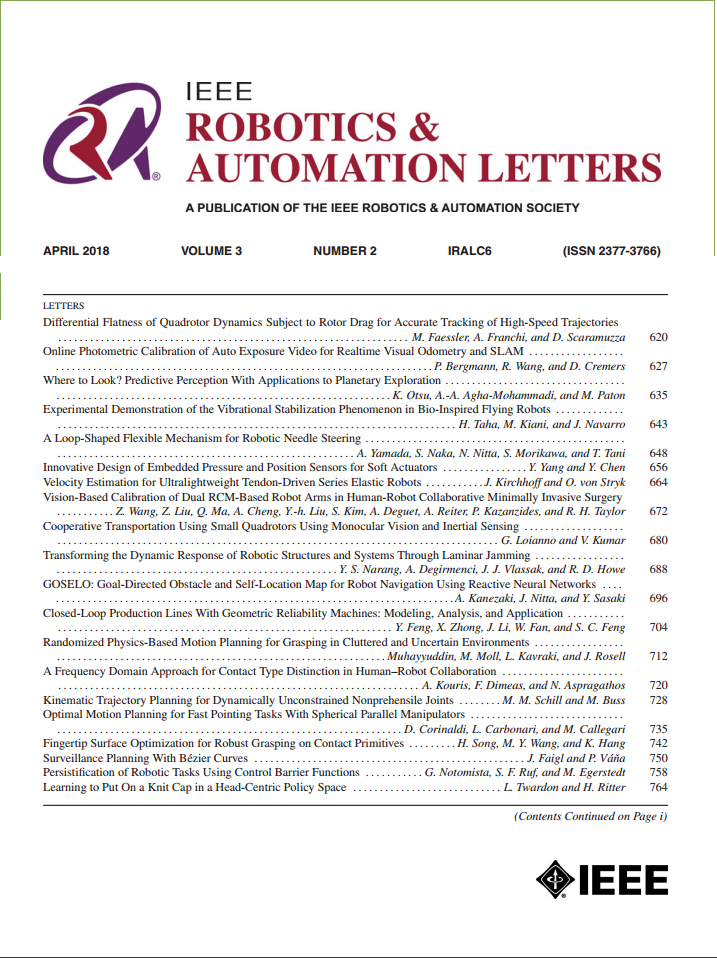拓扑场:基于大脑启发的分层布局-对象-位置场的拓扑映射
IF 4.6
2区 计算机科学
Q2 ROBOTICS
引用次数: 0
摘要
移动机器人需要全面的场景理解,以便在不同的环境中有效地操作,丰富的上下文信息,如布局,对象及其关系。尽管像神经辐射场(nerf)这样的技术进步提供了高保真的3D重建,但它们的计算量很大,而且往往缺乏规划和导航所必需的可穿越空间的有效表示。相比之下,拓扑图的计算效率很高,但缺乏更完整地理解环境所必需的语义丰富性。受后嗅皮质(POR)中的种群代码的启发,该代码强烈地调整到场景内容的空间布局上,迅速形成高级认知地图,本研究引入了Topo-Field框架,该框架将布局-对象-位置(LOP)关联集成到神经场中,并从该学习表征构建地形地图。LOP关联通过显式编码对象和布局信息来建模,而大型基础模型(Large Foundation Model, LFM)技术允许在没有大量注释的情况下进行有效的训练。然后通过查询学习到的神经表示来构建拓扑地图,提供了语义丰富和计算效率。在多房间环境中的经验评估证明了Topo-Field在位置属性推断、查询定位和地形规划等任务中的有效性,成功地弥合了高保真场景理解和高效机器人导航之间的差距。本文章由计算机程序翻译,如有差异,请以英文原文为准。
Topo-Field: Topometric Mapping With Brain-Inspired Hierarchical Layout-Object-Position Fields
Mobile robots require comprehensive scene understanding to operate effectively in diverse environments, enriched with contextual information such as layouts, objects, and their relationships. Although advances like neural radiance fields (NeRFs) offer high-fidelity 3D reconstructions, they are computationally intensive and often lack efficient representations of traversable spaces essential for planning and navigation. In contrast, topological maps are computationally efficient but lack the semantic richness necessary for a more complete understanding of the environment. Inspired by a population code in the postrhinal cortex (POR) strongly tuned to spatial layouts over scene content rapidly forming a high-level cognitive map, this work introduces Topo-Field, a framework that integrates Layout-Object-Position (LOP) associations into a neural field and constructs a topometric map from this learned representation. LOP associations are modeled by explicitly encoding object and layout information, while a Large Foundation Model (LFM) technique allows for efficient training without extensive annotations. The topometric map is then constructed by querying the learned neural representation, offering both semantic richness and computational efficiency. Empirical evaluations in multi-room environments demonstrate the effectiveness of Topo-Field in tasks such as position attribute inference, query localization, and topometric planning, successfully bridging the gap between high-fidelity scene understanding and efficient robotic navigation.
求助全文
通过发布文献求助,成功后即可免费获取论文全文。
去求助
来源期刊

IEEE Robotics and Automation Letters
Computer Science-Computer Science Applications
CiteScore
9.60
自引率
15.40%
发文量
1428
期刊介绍:
The scope of this journal is to publish peer-reviewed articles that provide a timely and concise account of innovative research ideas and application results, reporting significant theoretical findings and application case studies in areas of robotics and automation.
 求助内容:
求助内容: 应助结果提醒方式:
应助结果提醒方式:


